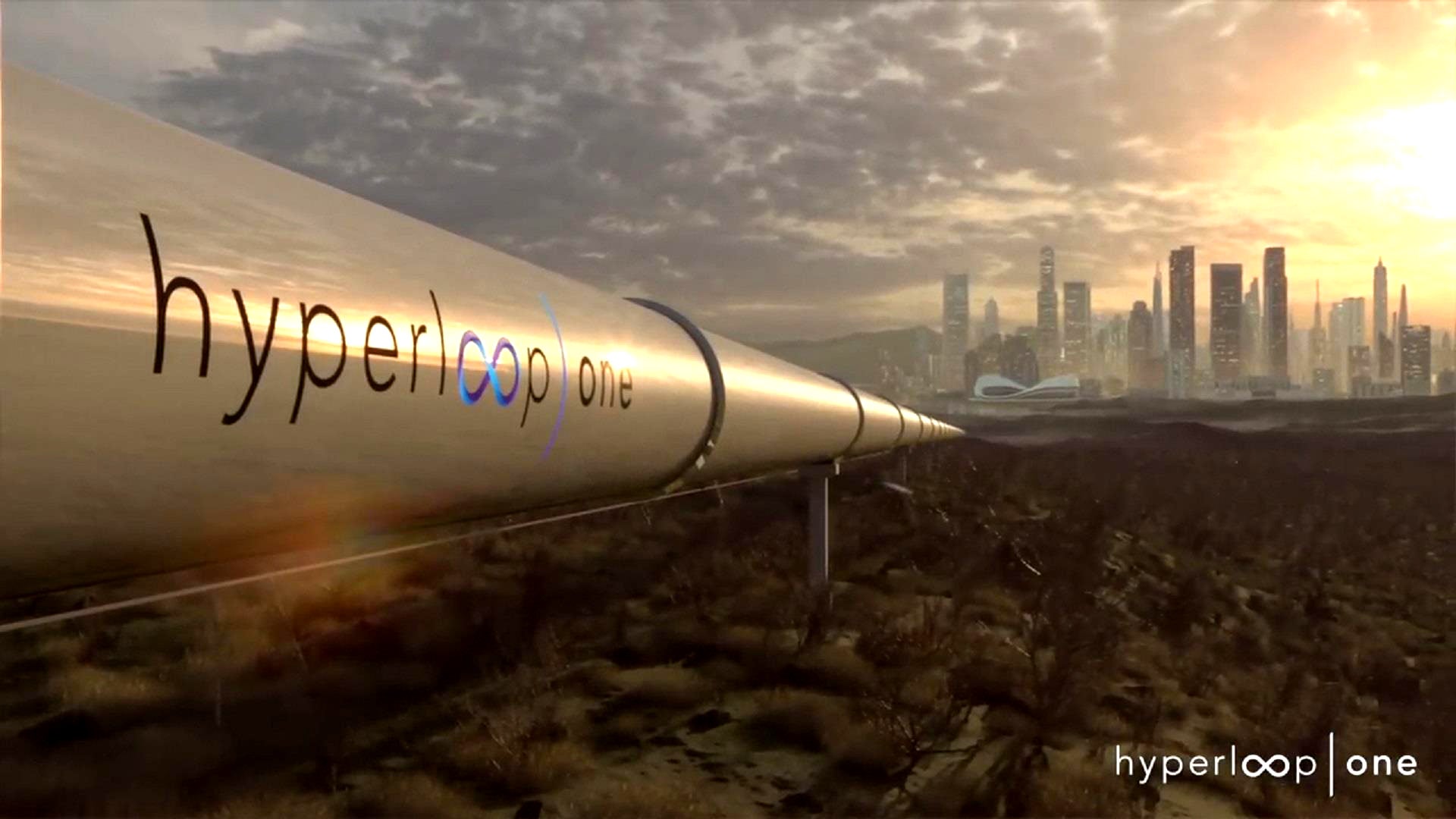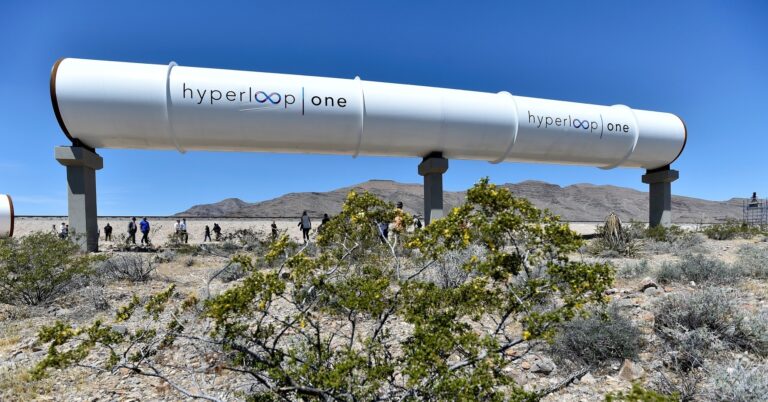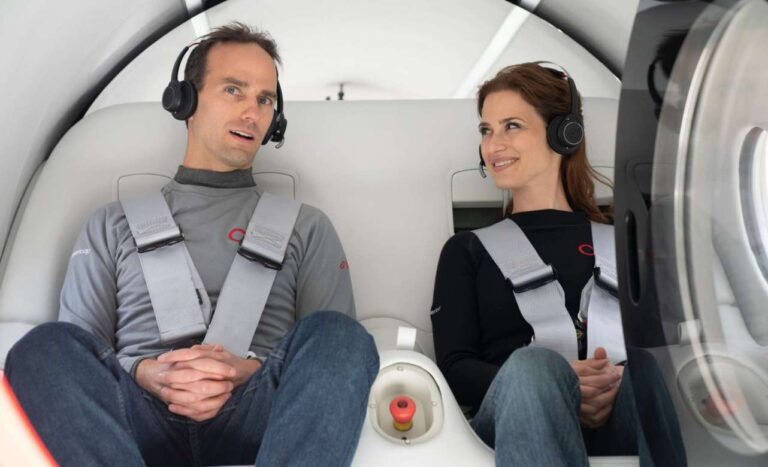MOAPA, Nev. — California just decided to sharply scale back its plans for a high-speed rail artery meant to transform travel up and down the state. But in the desert outside Las Vegas, the transportation ambitions still seem limitless.
Here, engineers working for Virgin Hyperloop One are testing a radically different type of mass transit: one that aims to move people and cargo in small wheel-less pods in a vacuum tube at speeds that could exceed 600 miles per hour. Today’s swiftest rail travel, at top speeds less than half as fast, would become a quaint anachronism.
The company, which counts Sir Richard Branson’s Virgin Group as a minority investor, is one of several in the United States, Canada and other countries developing hyperloop technology. The concept was promoted by Elon Musk, of electric-car and private-rocket renown, and then offered by one of his companies as open-source technology available to all. It works by propelling pods using magnetic levitation through a low-pressure, near-vacuum tube.
The low pressure minimizes friction and air resistance, greatly reducing the power needed. And because the pods travel in a tube, they’re not subject to shutdowns due to harsh weather, like snow or polar vortexes.
We’ve seen this concept before. Libraries used to send book requests to the stacks in pneumatic tubes. Until 1984, a similar network whisked messages around Paris. And a series of underground tubes once dispatched mail between Manhattan and Brooklyn.
The concept was even tried with people for three years in New York’s subway. Beginning in 1870, Beach Pneumatic Transit, named for its developer, ran a passenger capsule moved by pneumatic power under Broadway in Manhattan, from Warren Street to Murray Street.
Virgin Hyperloop One, based in Los Angeles, began testing here in 2017 and is now doing so with a full-scale test track; its main competitors, Hyperloop Transportation Technologies, also in Los Angeles, and TransPod, with headquarters in Toronto, expect to build their own test tracks this year. So far both are working with computer simulations.
In the barren desert 35 miles north of the Las Vegas Strip, Virgin’s 1,640-foot-long, 11-foot-high tube has been used for hundreds of runs, with an empty pod that in one test accelerated to 240 m.p.h.
Plans call for the commercialized system to reach a continuous 510 m.p.h., with 670 m.p.h. possible.

To avoid making anyone sick, the system would take three minutes to accelerate to that speed, and the train would need to travel six miles to turn 90 degrees, said Ismaeel Babur, one of the company’s senior civil engineers.
Because of its slow takeoff rate, “you’ll feel 30 to 40 percent of the acceleration compared to an airplane,” Mr. Babur said. The trip will be so smooth, he added, that “coffee won’t slide even at 600 miles per hour.”
Each of the three companies has raised tens to hundreds of millions of dollars and developed its own patented approach to long-distance mass transit. TransPod, with $52 million in capital, has preliminary agreements to build a six-mile test track for a route that would eventually span the 180 miles between Calgary and Edmonton in Alberta, as well as a shorter track near Limoges, France, for one of several French routes under consideration.
Hyperloop Transportation Technologies, which has raised $42 million, is in the design phase for a 1,100-yard test track in Abu Dhabi and is preparing to build a 350-yard test track in Toulouse, France.
Virgin, which has raised $295 million, is in the developmental stage with projects in India and Ohio. Last month, the Indian state of Maharashtra declared the company’s proposed hyperloop system between Pune and Mumbai as an official infrastructure project. Construction on a seven-mile test track could start this year, said Jay Walder, the company’s chief executive.
Passenger operations could begin by the middle of the next decade, cutting travel time between the cities to 30 minutes, one-fifth the current duration.

“The more we see, the more we find the technology to be compelling,” said William Murdock, executive director of the Mid-Ohio Regional Planning Commission, a nonprofit governmental transportation agency. Virgin Hyperloop One is working on a proposed system to connect Chicago, Columbus and Pittsburgh.
“Columbus is a freight logistics hub,” said Mr. Murdock, who hopes that the entire hyperloop route could be built in the next 10 years. “To commute quickly between Chicago and Pittsburgh would be fantastic.”
All three companies contend that because of energy cost advantages over other forms of transportation, a system will be able to break even in a decade after full-scale operations begin. Not only will commuters be able to get from place to place faster, but doing so will allow people to comfortably live far from their work, giving access to educational, cultural and health services normally out of reach.
Hyperloop developers expect pods to carry not only people but also high-value, low-weight cargo, offering an alternative to carriers using high-cost air transport, like FedEx and Amazon. In addition, they say, automobile manufacturers and others relying on just-in-time delivery of parts to keep inventory costs down would be able to get parts from distant locations.
While such visions are a distant dream, hyperloop companies have attracted key talent and enthusiastic municipalities.

Mr. Walder, Virgin Hyperloop One’s chief executive, is a former head of New York’s Metropolitan Transportation Authority and managing director at Transport for London. Before taking the job in November, he said, he asked Mr. Branson — who stepped down as Virgin Hyperloop One’s chairman last year — whether he was “still fully committed to this.”
“Not only was he committed, but he thought it was one of the most exciting things he’s ever done,” Mr. Walder said.
Hyperloop Transportation Technologies is taking a more holistic approach, looking to reinvent not only transport but also the way companies work and the way such a venture can be sustainably funded.
The company has only 50 full-time employees, but they’re augmented by 800 people around the world who work strictly for stock options, in exchange for putting in at least 10 hours per week on the project.
“This model gives us a fairly low burn rate,” said Dirk Ahlborn, the company’s founder and chief executive. “But there are communication challenges. Some teams work amazingly, and others do not perform at all. You’re competing with their free time, their wives and their babies. It’s definitely a different way to do things.”
Another difference from other transit systems will be the passenger experience. To keep the structural integrity of the near-vacuum tube, there will be no windows.

“People would get sick looking at trees passing by at 600 miles per hour,” said Sébastien Gendron, TransPod’s chief executive.
Instead, developers are looking at various exterior simulations that could be projected on large screens throughout the pod. “We could create a depth effect through video projection,” Mr. Gendron said. Even movies could be shown.
Mr. Ahlborn believes that showing advertisements and providing other services to travelers could provide additional income that would hold down fares.
“My vision is that the ticket model is not the best model,” he said. “We can enable a marketplace of services and generate a lot of money.”
But before such musings turn into reality, hyperloop proponents must prove that their systems work, that they’re safe for people and cargo and that they’re affordable.
“From the point of view of physics, hyperloop is doable,” said Garrett Reisman, professor of astronautical engineering at the University of Southern California and a former astronaut on the International Space Station.

The experience will be no different from riding in an airplane with the shades drawn, and technical issues around maintaining the vacuum within the tube will be solved, he believes.
Instead, hyperloop projects will face more mundane challenges.
“Getting innovative things through the regulatory and certification environments is very difficult,” Mr. Reisman said. “This could face an uphill battle in the U.S.”
Which companies will succeed, if any, is anyone’s guess. Yet each main player is rooting for the others, knowing that one failure will put a pall over the technology as a whole.
“The worst thing that would happen to us is if Virgin Hyperloop One is not successful,” Mr. Ahlborn said.
Whether any company can garner the necessary finance is still an open question, leading Mr. Ahlborn to wonder if any one can ultimately go it alone. “Maybe there could be a consolidation between our companies,” he said.
Rick Geddes, professor in the department of policy analysis and management at Cornell University, sees a different challenge. “The biggest problems for hyperloop will be securing rights of way and permitting,” he said.
Still, Professor Geddes believes that hyperloop systems will become a reality, as the time is ripe.
“There’s a sense that things are stale; we’re just adding to existing modes of transport,” he said. “Time is more and more a valuable commodity. The transportation industry is ready for a new way of thinking.”



